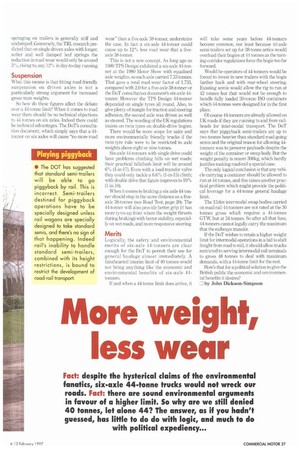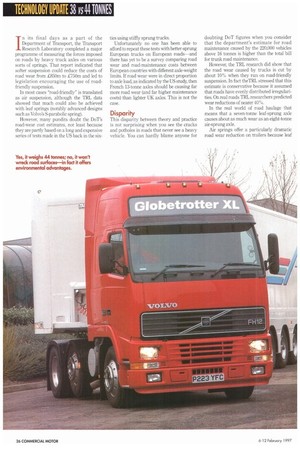More weight, less wear
Page 29

Page 28

If you've noticed an error in this article please click here to report it so we can fix it.
Fact: despite the hysterical claims of the environmental fanatics, six-axle 44-tonne trucks would not wreck our roads. Fact: there are sound environmental arguments in favour of a higher limit. So why are we still denied 40 tonnes, let alone 44? The answer, as if you hadn't guessed, has little to do do with logic, and much to do
with political expediency...
In its final days as a part of the Department of Transport, the Transport Research Laboratory completed a major programme of measuring the forces imposed on roads by heavy truck axles on various sorts of springs. That report indicated that softer suspension could reduce the costs of road wear from £850m to £750m and led to legislation encouraging the use of roadfriendly suspension.
In most cases "road-friendly" is translated as air suspension, although the TRL data showed that much could also be achieved with leaf springs (notably advanced designs such as Volvo's S-parabolic spring).
However, many pundits doubt the DoT's road-wear cost estimates, not least because they are partly based on a long and expensive series of tests made in the US back in the six
ties using stiffly sprung trucks.
Unfortunately no one has been able to afford to repeat these tests with better-sprung European trucks on European roads—and there has yet to be a survey comparing road wear and road-maintenance costs between European countries with different axle-weight limits. If road wear were in direct proportion to axle load, as indicated by the US study, then French 13-tonne axles should be causing far more road wear (and far higher maintenance costs) than lighter UK axles. This is not the case.
Disparity
This disparity between theory and practice is not surprising when you see the cracks and potholes in roads that never see a heavy vehicle. You can hardly blame anyone for doubting DoT figures when you consider that the department's estimate for road maintenance caused by the 220,000 vehicles above 16 tonnes is higher than the total bill for trunk road maintenance.
However, the TRL research did show that the road wear caused by trucks is cut by about 10% when they run on road-friendly suspension. In fact theTRL stressed that this estimate is conservative because it assumed that roads have evenly distributed irregularities. On real roads TRL researchers predicted wear reductions of nearer 40%.
In the real world of road haulage that means that a seven-tonne leaf-sprung axle causes about as much wear as an eight-tonne air-sprung axle.
Air springs offer a particularly dramatic road wear reduction on trailers because leaf springing on trailers is generally stiff and undamped. Conversely, the TRL research predicted that on single driven axles with longer, softer and well damped leaf springs the reduction in road wear would only be around 3%, rising to, say, 12% in day-to-day running
Suspension
What this means is that fitting road-friendly suspension on driven axles is not a particularly strong argument for increased gross train weights.
So how do these figures affect the debate over a 44-tonne limit? When it comes to road wear there should be no technical objections to 44 tonnes on six axles. Indeed there could be technical advantages. The DoT's consultation document, which simply says that a 44tanner on six axles will cause "no more road
wear" than a five-axle 38-tonner, understates the case. In fact a six ,axle 44-tonner could cause up to 12% less mad wear that a fiveaxle 38-tanner.
This is not a new concept. As long ago as 1980 TPS Design exhibited a six-axle 44-tonner at the 1980 Motor Show with equalised axle weights, so each axle carried 7.33 tonnes. That gave a total road-wear factor of 1/35, compared with 2.0 for a five-axle 38-tanner or the DoT consultation document's six-axle 44tonner. However the TPS Design 44-tonner depended on single tyres all round. Also, to give plenty of margin for fraction and steering adhesion, the second axle was driven as well as steered. The wording of the UK regulations insists on twin tyres on double-drive bogies.
There would be more scope for safer and more environmentally friendly trucks if the twin-tyre rule were to be restricted to axle weights above eight or nine tonnes.
Six-axle 44-tanners with single drive could have problems climbing hills on wet roads: their practical hillclimb limit will be around 6% 0-in-17). Even with a load-transfer valve they could only tackle a 6.6% (1-in-15) climb; with double drive that figure improves to 10% (1-in-10).
When it comes to braking a six-axle 44-tonner should stop in the same distance as a fiveaxle 38-tanner (see Road Test, page 20). The 44-tanner will also provide better grip fit has more tyres up front where the weight thrusts during braking) with better stability, especially on wet roads, and more responsive steering.
Merits
Logically, the safety and environmental merits of six-axle 44-tanners are clear enough for the DoT to permit their use for general haulage almost immediately. A fainthearted interim limit of 40 tonnes would not bring anything like the economic and environmental benefits of six-axle 44tonners.
If and when a 44-tonne limit does arrive, it will take some years before 44-tonners become common, not least because tri-axle semi-trailers set up for 38-tonne artics would overload their bogies at 44 tonnes as the turning-corridor regulations force the bogie too far forward.
Would-be operators of 44-tonners would be forced to invest in new trailers with the bogie farther back and with rear-wheel steering. Existing semis would allow the rig to run at 42 tonnes but that would not be enough to handle fully loaded 30-tonne ISO containers which 44-tonnes were designed for in the first place.
Of course 44-tonners are already allowed on UK roads if they are running to and from railheads for inter-modal transport. The DoT says that piggyback semi-trailers are up to two tonnes heavier than standard road-going semis and the original reason for allowing 44tonners was to preserve payloads despite the weight of the container or swap body But the weight penalty is nearer 300kg, which hardly justifies making road-rail a special case.
The only logical conclusion is that any vehicle carrying a container should be allowed to run at 44 tonnes, and this raises another practical problem which might provide the political leverage for a 441onne general haulage limit.
The 13.6m intermodal swap bodies carried on road-rail 44-tonners are not rated at the 30 tonnes gross which requires a 44-tonnes GTW, but at 34 tonnes. So after all that fuss, 44-tonners cannot legally carry the maximum that the railways transfer.
If the DoT wishes to retain a higher weight limit for intermodal operations in a bid to shift freight from road to rail, it should allow trucks restricted to serving intermodal rail tertninals to gross 48 tonnes to deal with maximum demands, with a 44-tonne limit for the rest.
How's that for a political solution to give the British public the economic and environmental benefits it desires?
by John Dickson-Simpson










































































































